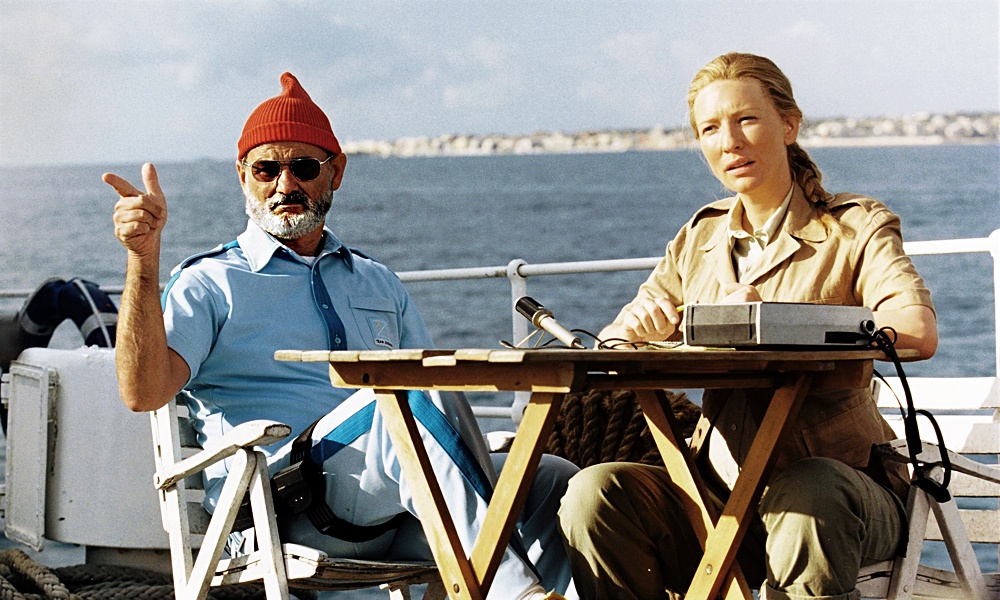While Rotten Tomatoes puts a nice succinct rating on a movie, it’s really just a conglomeration of people’s opinions. That might sound like we’re stating the obvious, but we’re always surprised at how often people forget critics are just people with opinions. So while it might seem like a pure, objective way of saying whether or not a movie is good, don’t let yourself be blinded by Rotten Tomato ratings. Waterworld only has a 42%, but that’s not stopping TNT from playing it whenever the NBA’s not on. Someone out there is watching a gilled-up Kevin Costner, and that’s okay. You’re allowed to like things other people don’t like. Whether you download these or stream them on Netflix or Amazon, don’t let the ratings deter you.
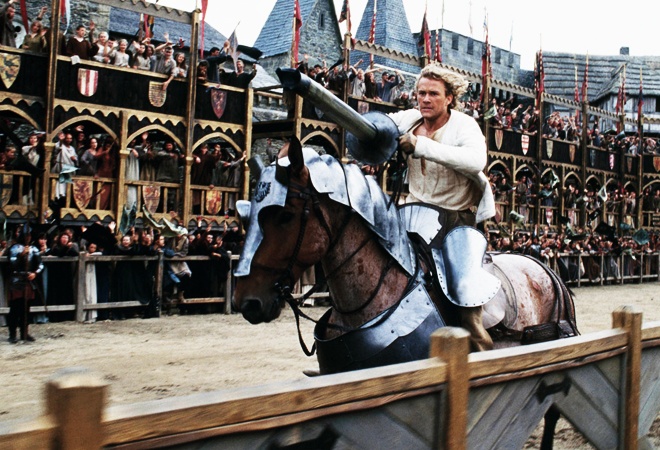
A Knight’s Tale
(58%)
Calling A Knight’s Tale a guilty pleasure feels somewhat like a disservice. There are absolutely guilty aspects to it. Sappy romance, deus ex machina, shameless pandering to English majors, is all there. But there’s also genuinely good filmmaking and storytelling being done, with solid characters and fresh takes on a fairly tired setting.
For one, having Geoffrey Chaucer be Sir Ulrich von Lichtenstein’s hype man is brilliant. Where most other knight’s introductions focus on describing his pedigree to whatever nobility is presiding over the tournament, Chaucer’s speeches get a reaction not unlike modern wrestling, with the crowds chanting, cheering, and hooting whenever Sir Ulrich is about to compete. The movie’s also not afraid to explore the 14th century with anachronistic 1970s rock, with Queen and David Bowie providing the soundtrack. Which, now that we think about it, is probably more tonally accurate. Jousting tournaments weren’t dry, boring events nobility put on for show. They were also supposed to be fun entertainment for their subjects.
In fact, that’s our main attraction to this movie. Where other filmmakers think too much about creating profound art or speaking truth to power, writer and director Brian Helgeland clearly just wanted to have fun and wanted the same for his audience. You can watch it and feel guiltlessly good about how you just spent two hours.
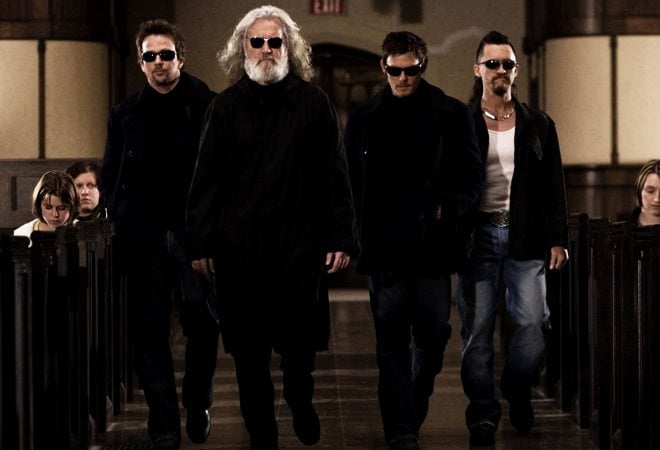
The Boondock Saints
(20%)
There’s something shameless about enjoying The Boondock Saints, and that seems to be reflected in the huge gap between critics’ opinions of the movie and the audience’s. Only 20% of critics had anything good to say about this movie, while 91% of audience reviews are positive, most of them overwhelmingly so. People could, and probably have, written papers and books about why audiences loved The Boondock Saints so much more than critics, and their conclusion would finally spell out the difference between why critics go see movies and what an audience wants from the experience.
Make no mistake, The Boondock Saints is a self-indulgent crime thriller, presenting the Irish in America closer to stereotypes than real people. But that’s not always a bad thing, as it enables this movie to get right to what people really want to see, which is two guys shoot a lot of people. Sure they’re trying to clean up their neighborhood, but people don’t watch or read Batman to see Gotham get better. They want to see Batman kick the shit out of 15 people at once. It’s the same with Boondock Saints. Amazon
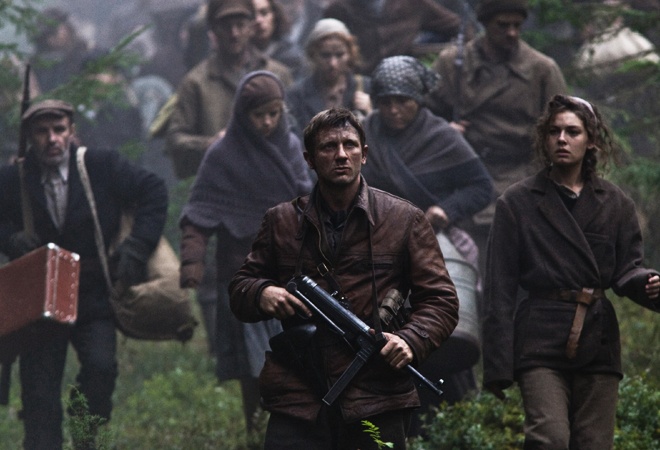
Defiance
(57%)
A lot of the criticism of Defiance has to do with turning the story of a group of Jewish refugees into an action heavy WWII film and the overuse of certain Hollywood cliches. That’s not misplaced criticism, as those elements are certainly present, but thinking about it, this movie did what very few movies and stories about Jewish refugees do, which is to make the Jews the soldiers in their own fight.
We’ve heard plenty of stories about heroic bureaucrats like Oskar Schindler using political power to smuggle Jews out of Germany, but in those stories, it feels like the Jews are a helpless, frightened herd. To be sure, there’s no shame in feeling helpless or frightened when one of the most evil empires in modern history is actively campaigning for your extinction, but it’s still a compelling switch to see the refugees become a competent guerilla force. Critics can talk about cliches and tropes, but that doesn’t make watching a group of guerilla Jews trading volleys with their Nazi pursuers any less empowering. Netflix

Gangster Squad
(31%)
This is one movie where it seems we disagree with most critics and a significant chunk of the audience. You’ve already seen the Rotten Tomatoes Score and only 57% of the audience liked this movie. We can’t figure out why. It’s not breaking any hugely original ground, but all the core things we like about movies are here. Josh Brolin is a brawling, headstrong cop, Anthony Mackie’s character is close to Falcon from the Avengers movies, Ryan Gosling and Emma Stone have their always solid relationship performances, and Giovanni Ribisi is always excellent.
As you’d expect, there’s a solid noir look to the movie, though with some interesting modern updates to the form. There are some camera tricks employed throughout that set Gangster Squad apart in the genre and the violence is more visceral than your traditional 1940s detective story. Visually, it’s never boring, and the plot moves quick enough there’s no pause in the action.
From the reviews, it looks like the critics expected a gangster movie that was violent but not too violent, contained spectacle but also subtlety, subverted the noir genre while paying earnest homage to it, had understated performances that were as energetic as they come, was fun with profundity, and was, above all, original. If you go in with expectations like that for any movie, you’re going to be disappointed. This was a shoot-em-up about gangsters, after all.
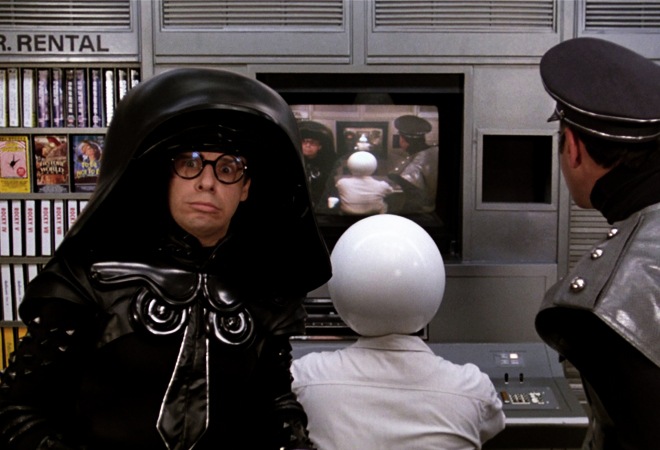
Spaceballs
(54%)
Mel Brooks isn’t one of the names we thought we’d be including on here, especially for Spaceballs. Blazing Saddles scored an insanely high 90% and, tonally, we can’t think of much of a difference. Both are irreverent, both have anachronistically Jewish characters, and both satirize highly popular genres. They both smash the fourth wall and incorporate absurdist elements. Maybe it’s just us, but save for the setting, we can’t really tell the difference between the movies.
Yet somehow, Spaceballs is 36% worse than Blazing Saddles. We’ve been trying to think of an explanation and the only one that comes to mind is Mel Brooks fatigue. He was writing and directing a lot of movies in the 60s, 70s, 80s, and slowing down in the 90s, so maybe people just started to get a little tired of his style by 1987. We get that. We probably wouldn’t be able to marathon The Producers, Blazing Saddles, Young Frankenstein, and Spaceballs all in the same day. You may need some time in between Brooks’ productions, but that doesn’t mean they’re bad movies.
Also surprising about the movie is how a Rick Moranis performance this good could be in a movie this low rated. The guy brought his A game and it’s like the critics completely ignored it. He’s half the reason the movie is so quotable. Starz
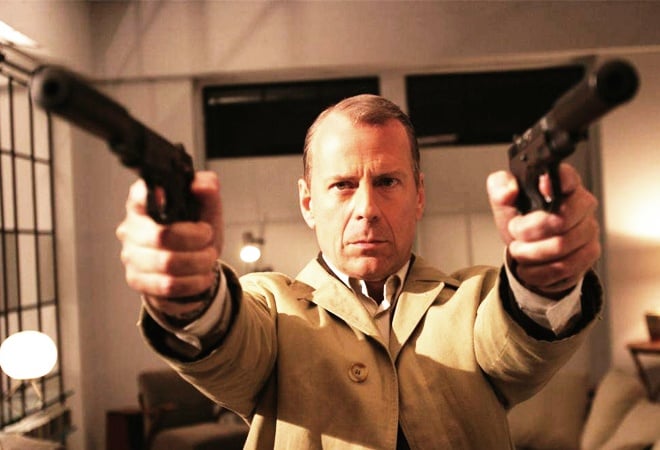
Lucky Number Slevin
(51%)
If this is going to be what you spend movie night with, make sure you haven’t watched anything by Guy Ritchie or Quentin Tarantino and maybe Shane Black for at least a month. This is to help you avoid a lot of the problems critics had. Most of them thought of the movie as too much of a knockoff of well-established movies and directors, but our thinking falls somewhere in line of “can’t see the forest for the trees.” Yes the movie has a lot of similarities with movies we already like, but there’s a lot more than that going on.
For one, Morgan Freeman doesn’t play a villain very often, so him being cast as one of the two mob bosses of the film adds an uncommon twist. Second, there are a few twists and turns you should be able to see coming, but probably won’t thanks to how well acted the movie is. We also like it because it’s stylistically distinct from other movies we’ve seen. For people who have already seen the movie, it only takes a few frames for them to recognize what they’ve walked in on. It’s a breath of originality in a genre where it seems like everyone and their grandmother thinks they can make a movie. Netflix
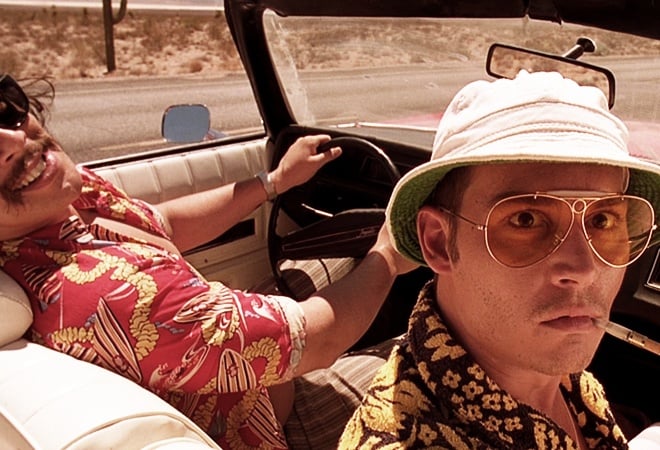
Fear and Loathing in Las Vegas
(49%)
Apparently the lion’s share of criticism for Fear and Loathing in Las Vegas concerned its incoherency. To those people we say, did you not listen to the briefcase list? If you watch that, then think you’re about to watch a straightforward movie, you probably shouldn’t be professionally watching movies. The drug inventory of the first first 90 seconds of the movie should completely dispel any rumors that this is a one-and-done movie. You’ll need more than one session if you’re going to put together any real sense of completeness. That has to be the point too. Terry Gilliam’s no idiot. If he’s making a movie where his characters do a lot of drugs, he’s going to make the audience feel it as well.
Critics also seemed to have missed another part of the point of the story. Fear and Loathing’s drug scenes aren’t repellant because they’re poorly made nonsense. They’re repellant because Dr. Gonzo has no goddamn clue how to handle drugs, is totally unpredictable, and is most likely going to get himself and Raoul (“not” Hunter S. Thompson) killed. He’s a terrifying entity to be around with no regard for himself or others. If the audience is uncomfortable or alienated, that’s a direct comment on how Johnny Depp’s character feels. Which means the movie accomplished its goals and that some critics aren’t great at seeing what’s literally being spelled out for them. Starz
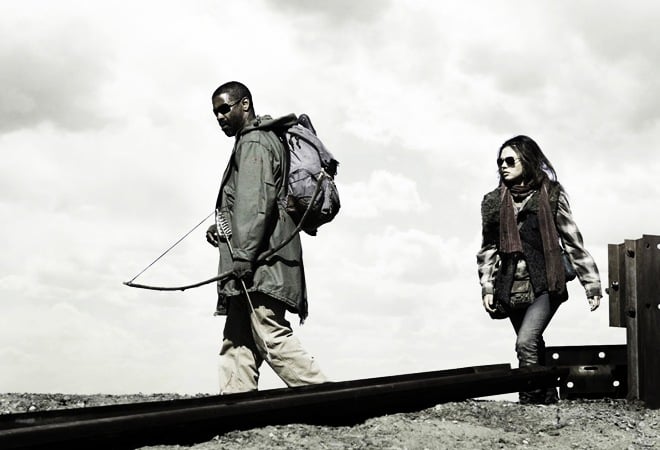
The Book of Eli
(48%)
We’ll admit, a major reason we liked this movie when we first saw it was Fallout 3. We were coming off a two year bender back in 2010 and one of the first things we saw when we rejoined society was The Book of Eli. It was like we hadn’t stopped playing and may just be the closest thing we’ll ever have to a screen adaptation of Fallout. That should be enough to convince anyone who’s played the games to watch this movie.
The reviews for it are interesting to scroll through, mostly because they’re so contradictory. The Book of Eli has religious elements to it. A few critics said the symbolism was used well and avoided heavy handed metaphors or morals. Then, three reviews down, someone’s ripping apart the movie for its self-righteous religious tone. Another one talks about how much fun the actors are having indulging themselves in a violent action movie, while another talks about how Denzel Washington doesn’t look to be having anywhere near a good time. Another guy just likes to mix metaphors, talking about killing cats and screwing pooches, and it seems like he was really patting himself on the back for his cleverness without thinking about how his metaphor doesn’t make sense.

The Sandlot
(58%)
The Sandlot is one of those movies you see as a kid and sticks with you for years afterward, though the best part might be the way the movie ages. It changes based on how old you are when you watch it, though it always retains that core of pure childhood fun. It holds up. It’s not some cheap throwaway movie parents suffer through for an extended, obsessive period of their child’s lives. This is a movie you remember watching with your parents or grandparents for years.
That’s why the Rotten Tomatoes score is so surprising. For a movie like this to score below a 60, there had to be a fundamental disconnect between critic and movie. If we had to guess, we’d say cynical people wouldn’t like this movie, mostly because there’s absolutely no room for cynicism in it. Even the guy who had the most call to be cynical, a former Negro Leagues player, is upbeat about just about everything that happens to him. If that guy can find the silver lining of life, then what’s up with these critics?
Luckily, audiences seem to agree with us here. It’s one of the bigger critic/audience splits, 89% of audience reviews are positive, and that’s 89% of nearly 261,000 reviews. That number is accurate in real life too. We can’t remember talking to anyone who didn’t like The Sandlot, and for most people, it’s their most positive memory of baseball.
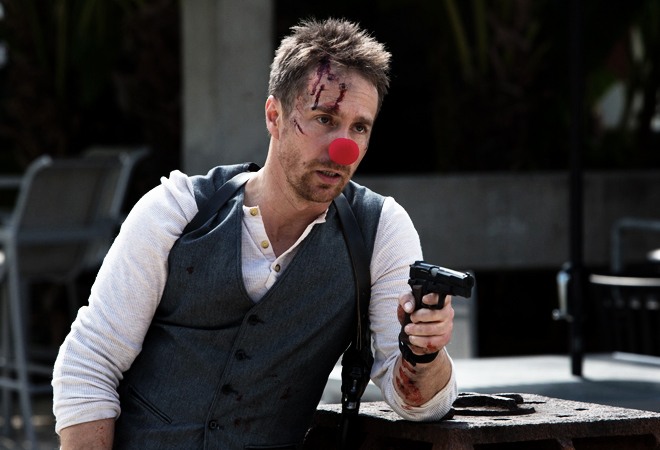
Mr. Right
(42%)
Our recommendation for this movie comes mostly from how much we like Sam Rockwell. He’s excellent at playing witty, easy-going roles with dark twists. What’s more, Anna Kendrick hits a lot of the same notes in her performance and their characters in this movie play off each other with an easy chemistry most buddy cop or rom-coms can’t achieve no matter how hard they try. We wouldn’t be surprised if this movie was written after the screenwriter saw Pitch Perfect and Seven Psychopaths in the same afternoon.
This movie certainly doesn’t deserve the rating it got, but some of the criticism is valid. Anna Kendrick’s character could do with a little more development, the pacing can be chaotic at certain points, and there are a few plot jumps that are hard to follow. But for us, the performances far outshine any problems we have. Rockwell and Kendrick have banter befitting their talents and Mr. Right’s rapport with Steve the mercenary is one of the highlights of the movie.
It’s a perfect movie for an afternoon where you don’t want to think too hard about what you’re watching, but you still want to watch something worthwhile. That, and it’s an excellent compromise if you and your girlfriend have polar opposite taste in movies, or are just having a night where you can’t agree on what to watch. There are plenty of fun rom-com antics, plenty of people get shot, and neither one is unbalanced. Make this a feature of a violent date night. HBO

Enemy at the Gates
(54%)
Stalin’s strategy for turning back the tide of German aggression didn’t rely much on tactics or military maneuvering, unless that maneuver was “force our guys to run straight at the Germans.” For everything horrible we’ve read or seen about the Western Front in the Second World War, the cruelty doesn’t begin to approach what was happening on the Eastern one. It’s why stuff like the Malmedy Massacre was shocking to Americans, but was another Tuesday to Soviets. That difference could be why we don’t see much in the way of Soviet war movies.
It could also be why Enemy at the Gates felt like it needed to explicitly tell us what the moral of this movie is. At one point, a Soviet commander is berating his subordinates, demanding ideas about how to get his troops to fight harder. Most of the suggestions are some variation on, “let’s shoot more of our own people,” wonderfully demonstrating the imagination of the Red Army. Luckily, the one he actually listens to is to use heroics and inspiration to motivate the troops, not fear and murder.
There’s a little more romance than we might need, more philosophizing than you might find in most Soviet era battlefields, and not quite enough characterization for some. But as a war story, Enemy at the Gates does an excellent job conveying the desolate destruction of Stalingrad, and the heart-pounding suspense of the cities sniper battles. Most of the movie has Ed Harris stalking Jude Law, and as we learned from Westworld, being stalked by Ed Harris is pants-shittingly terrifying.

Last Action Hero
(37%)
Last Action Hero was uniquely ahead of its time. We say uniquely because, tonally, the movie fits much better in the current climate of self-aware humor and ironic satire, but wouldn’t work without Arnold Schwarzenegger as the hero. No one before or after the Governator has come close to his level of action movie stardom, and 1993 Schwarzenegger is the only actor who could make this movie. It takes all the tropes of his career and lampoons them, but in a way that feels more like paying humorous homage than ridiculing or skewering.
It’s actually a tone we wish we had more of. Filmmakers today, especially in the action genre, seem like they don’t believe in their material. As soon as a scene with substance comes on, so a character basically winks at the camera and condescendingly says, “so dramatic.” It undermines the movie and strips meaning from the script. It’s almost as if Last Action Hero saw that coming and calls attention to it by having scenes that actually have meaning. It makes jokes at the expense of action movies, but never mean-spirited or destructive ones. This was a movie clearly made by people who love action movies.
A bit of the satire seemed to go over critics heads. Something about Schwarzenegger’s inclusion in the movie, especially with him at the height of his stardom, blinded them to the more self-aware aspects of the movie. They didn’t seem to think Schwarzenegger was capable of poking some fun at himself, so they took the movie to be closer to The Terminator or Predator. Crackle
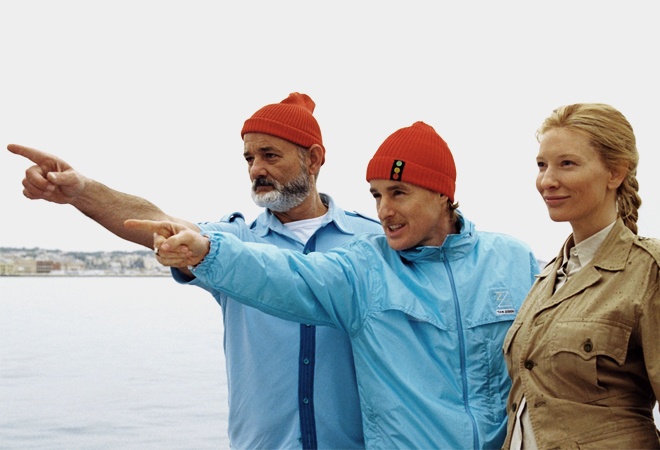
The Life Aquatic with Steve Zissou
(56%)
The fact that Wes Anderson makes this list should tell us definitively that there are movies whose reception critics can’t affect. Of everything Wes Anderson has made, this is the movie we hear about the most. It comes up when people talk about their favorite Wes Anderson movie or Bill Murray’s top performances and you can bet Halloween will see at least one or two Zissou team members wandering around.
This is Wes Anderson at his most Wes Andersonian. Colors pop, weird camera tricks and movements are everywhere, Bill Murray and Owen Wilson are in it. The plot centers around an absurd revenge fantasy. There’s nothing in here that Wes Anderson fans won’t love. In fact, chances are you’ve already seen it, so take this more as a cue to go rewatch it. Hulu

